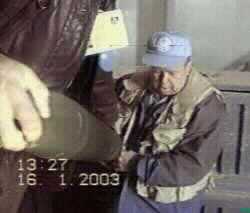Iraq had tens of thousands of 122 mm rockets, and thousands are unaccounted for, so the discovery by U.N. inspectors of 12 warheads for the rockets isn't surprising, former U.N. inspectors say.U.N. weapons inspectors in Baghdad said Thursday they were empty chemical warheads for 122 mm rockets that Iraq did not list in its December declaration to the Security Council. But Iraq said they were not for biological or chemical use and had been declared in their 12,000-page report.
The former inspectors said this raised the issue of whether the warheads were intended to be used for chemical warfare or conventional fighting.
Chief U.N. inspector Hans Blix, who is in charge of chemical inspections, said Friday in Paris that "clearly they were designed to carry chemical weapons" and should be destroyed. He said he wasn't sure whether Iraq had mentioned them in the declaration.
Blix's inspectors, who have not yet completed translating Arab documents in the declaration, asked Iraq on Friday to tell them where in the declaration the warheads were mentioned. They did not receive an immediate reply, U.N. sources said, speaking on condition of anonymity.
The United States has translated the declaration and White House spokesman Ari Fleischer said Friday "the chemical warheads found by the inspectors were not - not - on the declared list of weapons."
Under U.N. resolutions, Iraq is required to declare all its chemical munitions and destroy them under supervision of U.N. inspectors. But Iraq is allowed to have conventional 122 mm rockets containing explosives, said Terry Taylor, a former U.N. inspector who heads the Washington office of the London-based International Institute for Strategic Studies.
He said Iraq had tens of thousands of these rockets, which have a range of over 6 miles. Thousands were filled with chemical agents and about 26,500 of these 122 mm rockets that Iraq claims it destroyed have not been accounted for.
Raymond Zilinskas, a former inspector who now directs the chemical and biological weapons nonproliferation program at the Monterey Institute of International Studies in California, said there were three possibilities.
The warheads may never have been filled with a chemical agent, they might have been filled but were emptied before inspectors left in 1998, or the warheads were filled and emptied recently, he said in an interview.
If they were emptied recently, "that would be a very serious issue because the Iraqis have declared that they don't have any of the stuff, and that could lead to `material breach' being declared under Resolution 1441," he said. The resolution gave Iraq a last chance to disarm and threatened serious consequences if it didn't.
If the 12 warheads were chemical warheads but had never been filled, however, Zilinskas said it would be "a very, very small story" because it would only show that a very small number had escaped destruction.
"They're going to have to test to see if there are any traces of chemical weapons in the warheads and in the bunkers where they were found," said David Albright, president of the Institute for Science and International Security. "And they will have to talk to the Iraqis."
Taylor said that between 1992 and 1994, former U.N. inspectors destroyed 11,500 unfilled 122 mm rockets designed for chemical use.
Another 6,454 of these rockets filled with the deadly nerve agent sarin were accounted for and destroyed by inspectors between 1992 and 1993. Remnants of about 4,000 additional rockets with chemical agents were accounted for between 1991 and 1998, he said.
PHOTO CAPTION
In this image taken from video provided by Iraqi TV, UN weapons inspectors carry one of 11 undeclared but empty chemical warheads when it was found Thursday, Jan. 16, 2003 in an ammunition depot at Ukhaydir, south of Baghdad. (AP Photo/Iraqi T
- Author:
& News Agencies - Section:
WORLD HEADLINES


 Home
Home Discover Islam
Discover Islam Quran Recitations
Quran Recitations Lectures
Lectures
 Fatwa
Fatwa Articles
Articles Fiqh
Fiqh E-Books
E-Books Boys & Girls
Boys & Girls  Hajj Rulings
Hajj Rulings Hajj Fatwas
Hajj Fatwas














